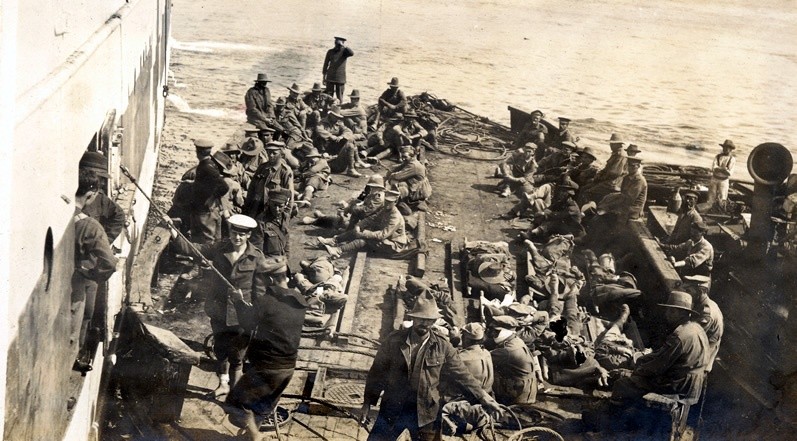Guest blogger: Mark Clayton
On 20th April 2015 seven children will travel from the small North Otago (New Zealand) town of Maheno to Fraser Island, bringing with them a large ship’s bell. Their reason…..to commemorate Anzac Day 2015 alongside the skeletal wreck of the S.S. Maheno. As preparations intensify here for the Gallipoli landing centenary - and thousands prepare to make the long-haul flight to Istanbul – the fanfareless arrival of these pilgrims delivers us a timely reminder that Australia’s largest Gallipoli relic is to be found not on the ravaged slopes of the Dardanelles, or in the Australian War Memorial’s solemn galleries.

The wreck of the S.S. Maheno as she appears today on the seaward shores of Fraser Island. Paul Candlin, Department of the Environment, RT66772
Instead, it’s here on our proverbial doorstep, half-buried in the white sands of the World Heritage-listed Fraser Island, that you’ll find the rusting hulk of the former Gallipoli hospital ship s.s. Maheno.
A luxury liner built originally for to the Union Company of New Zealand, the Maheno was originally employed on passenger routes between Sydney and Melbourne via ports in New Zealand and Hobart. Like most other ocean-going vessels at that time – Maheno was requisitioned for military service following the outbreak of the war in 1914 for use as a hospital ship. To this end, she was retrofitted with “a laboratory, a laundry and drying-room, steam disinfector, dispensary, telephone exchange, and two electric lifts each of which took two stretchers at a time. In short, she was complete in every detail….and patients could be as well cared for aboard as in hospitals ashore” (†). The ship’s wartime crew also included a medical team consisting of five doctors and 61 orderlies from the Army Medical Corps, a matron, thirteen nursing sisters, and chaplains.

Her first deployment to the Dardanelles was on 26th August 1915 where she embarked 455 patients. The severely wounded were sent to the wards at once, and the lightly injured were fed and surgically dressed on deck and sent in lighters to Mudros. The two operating theatres were in constant use. Maheno repeated this evacuation cycle for most of the Gallipoli campaign, completing her final Gallipoli deployment on 11th November 1915 by which time, her crew had evacuated more than 2,000 soldiers (mostly Australians).
The Maheno’s side doors greatly simplified the loading and unloading of patients. On 25 August 1915, during the battle for Hill 60, more than 1,000 wounded soldiers boarded on one side of the Maheno for treatment at dressing tables. The 400 who could walk were then sent to the other side of the ship to board lighters for transfer to other vessels.
The following year she joined the great White Fleet (Article 5 of the 1899 Hague Convention required hospital ships to painted white overall, with a broad green stripe along their sides, and large red crosses on their sides and funnels) ferrying almost 16,000 sick and wounded across the English Channel from the Somme battlefields, which included 606 Australians and 973 wounded German prisoners. Maheno continued as a hospital ship for the remainder of the war, subsequently reverting to her commercial liner role.
It was after her decommissioning, while being towed to a Japanese ship-breaker in July 1935, that she broke adrift and beached on the northern shores of Fraser Island. During the Second World War the ship’s hulk, stripped by then of all saleable assets, was used for live firing practice by the Royal Australian Air Force.
Ironically, it is the ship’s shattered and rusted appearance which has helped sustain the public’s interest in this veteran, particularly in recent decades. Successive local, State and Federal tourism authorities have for many years now been capitalizing on the wreck’s incongruity, slickly packaged imagery of this steel behemoth, stranded on the pristine shores of a World Heritage-listed island helping to routinely attract an estimated 90,000 visitors to each year.
Thanks to seven school children from a tiny trans-Tasman township, we’re reminded – forcefully – that one of the Gallipoli campaign’s largest relics survives still, here in Queensland.
Reference:
† Lt H Drew, The War Effort of New Zealand (1923), p.12
Comments
Your email address will not be published.
We welcome relevant, respectful comments.